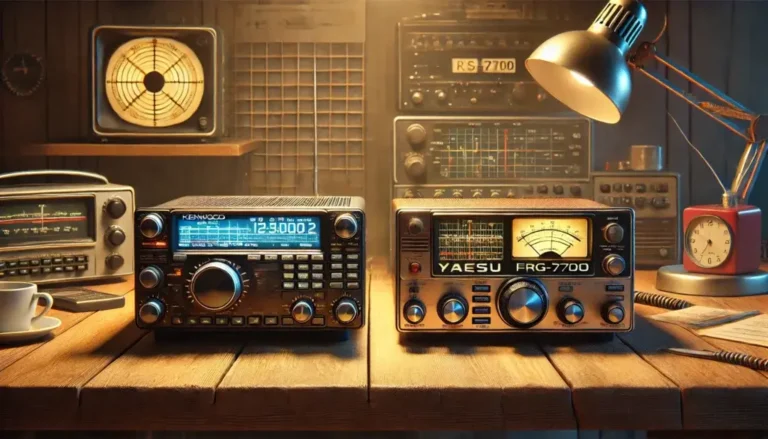
In the international of amateur radio Kenwood ts2000 vs yaesu frg 7700 choosing the proper transceiver can extensively impact your operational talents and universal enjoy.Well-known fashions that frequently arise in discussions and comparisons are the kenwood ts2000 and the yaesu frg 7700.
Both devices have their personal precise capabilities, pros, and cons that cater to extraordinary user choices and programs. In this article, we can discover these models in-intensity—covering layout, features, overall performance, and general price—to help you determine which is probably the higher desire for your needs.
Overview of kenwood ts2000
The kenwood ts2000 is a hybrid transceiver, which means that it combines each analog and virtual technologies to provide novice radio lovers with a flexible tool. Released in the early 2000s, the ts2000 quickly received recognition for its complete feature set, which include:
Hf, vhf, and uhf operation: the ts2000 is capable of transmitting and receiving across all novice bands from 1.Eight mhz to one.2 ghz, making it an tremendous preference for people who need an all-in-one answer.
Multiple modes: this transceiver helps a wide variety of working modes, such as ssb, cw, fm, am, and digital modes, which allow operators to adapt to exceptional conditions efficiently.
Integrated tuner: the ts2000 includes an inner antenna tuner, improving its usability via permitting customers to healthy diverse antennas without having an external unit.
7-inch colour display: the ts2000 capabilities an clean-to-study, excessive-decision color show that offers valuable information at a look and enhances users’ operational revel in.
Performance
With regards to performance, the kenwood ts2000 stands out way to capabilities which includes:
Noise reduction: kenwood has included advanced noise blanking and automated noise discount capabilities, which work to improve signal clarity in noisy environments.
Dsp (virtual sign processing): the inclusion of dsp technology similarly complements the audio best, permitting users to experience clearer communications with decreased interference.
Person-pleasant interface: the format and controls are designed to be intuitive, making it less complicated for both novices and experienced operators to navigate the device.
Assessment of yaesu frg 7700
The yaesu frg 7700, on the other hand, is an older version that holds a specific appeal for creditors and people who respect traditional hf receivers. Launched in the 1980s, the frg 7700 has a reputation for being a rugged and dependable device, geared up with capabilities tailor-made to shortwave listening:
Wide frequency insurance: the frg 7700 covers a vast range of frequencies, from one hundred fifty khz to 30 mhz (hf variety), which may be especially appealing for swl (quick wave listening) fanatics.
Reminiscence channels: this receiver offers several memory channels (as much as a hundred), permitting customers to keep their preferred frequencies for brief get admission to.
Selectivity: the unit boasts remarkable selectivity, permitting listeners to filter adjoining indicators efficiently, hence enhancing reception high-quality.
Am and ssb modes: the capability to receive both amplitude-modulated (am) and single-sideband (ssb) signals caters to numerous listening options.
Performance
The yaesu frg 7700 retains its legacy due to amazing performance traits:
Analog tuning: at the same time as no longer as advanced as virtual tuning systems, the analog tuning gives a nostalgic experience for traditional radio fanatics.
Robust construct first-rate: this model is thought for its sturdiness, making it a terrific associate for outside expeditions or discipline days.
Person-friendly format: with its honest dial and knob format, new users can quick learn to perform the frg 7700 with none steep mastering curve.
Key comparisons: kenwood ts2000 vs. Yaesu frg 7700
Whilst weighing the kenwood ts2000 towards the yaesu frg 7700, numerous key factors come into play. Here, we will spotlight those differences to help you in addition on your choice-making process.
1. Motive and versatility
Kenwood ts2000: designed for the ham radio operator, the ts2000’s versatility across hf, vhf, and uhf bands makes it appropriate for each casual operations and extreme contesting or dxing.
Yaesu frg 7700: the frg 7700 is mostly a receiver with exquisite overall performance for shortwave listening, making it less flexible for transmitting functionalities. It may enchantment extra to hobbyists targeted on listening instead of communication.
2. Generation and features
Kenwood ts2000: ready with dsp, noise reduction, and superior digital technology, this version excels in each reception and transmission skills, presenting a person-friendly revel in with current operational capabilities.
Yaesu frg 7700: while the frg 7700 embraces an older layout with specially analog features, it possesses attraction rooted in simplicity. But, it lacks the superior functionalities of the ts2000.
3. Shape element and build satisfactory
Kenwood ts2000: the construct is strong, with a graceful current design, proposing a large, legible show.
Yaesu frg 7700: the frg 7700 is extra compact and rugged, facilitating portability and simplicity of use for outdoor operations.
4. Network and assist
Kenwood ts2000: being a more recent version, it is subsidized by using a wealth of on-line resources and communities that proportion expertise, troubleshooting suggestions, and improvements.
Yaesu frg 7700: its antique reputation has spawned a niche community of fans who recognize analog systems and proportion insights on maintaining those traditional gadgets.
Conclusion: which one to select?
In concluding our contrast of the kenwood ts2000 vs yaesu frg 7700, it in the long run boils all the way down to your precise wishes and choices as an operator. In case you are seeking out a multifunctional, current hybrid transceiver suitable for each informal and advanced use, the kenwood ts2000 sticks out as a clean winner. Its great range of features, along its ability to operate on multiple frequencies, makes it an incredible device for the severe amateur radio operator.
However, in case your number one hobby lies in shortwave listening and also you cherish the nostalgia of analog structures, the yaesu frg 7700 is a extraordinary addition in your series. Its strong overall performance for receiving hf signals and simplicity of use makes it an excellent desire for folks that respect conventional radio devices.
In the end, each models have their strengths and flaws, but understanding their abilties and targeting your unique hobbies will guide you closer to making the nice preference to your newbie radio journey.





